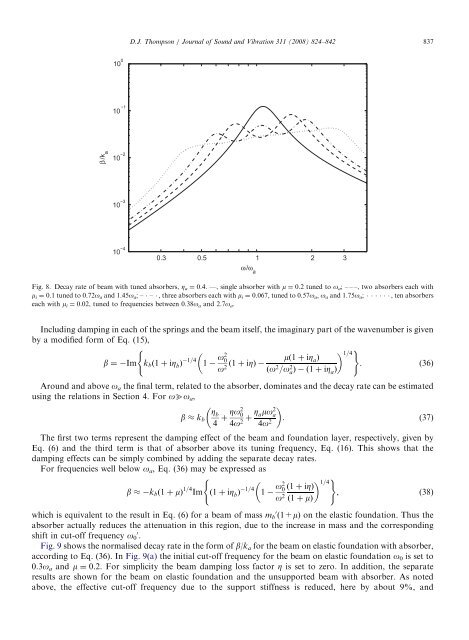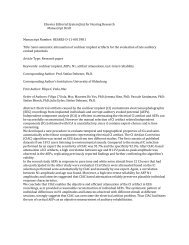A continuous damped vibration absorber to reduce broad-band ...
A continuous damped vibration absorber to reduce broad-band ...
A continuous damped vibration absorber to reduce broad-band ...
Create successful ePaper yourself
Turn your PDF publications into a flip-book with our unique Google optimized e-Paper software.
β /k a<br />
10 0<br />
10<br />
10<br />
10<br />
10<br />
ARTICLE IN PRESS<br />
D.J. Thompson / Journal of Sound and Vibration 311 (2008) 824–842 837<br />
0.3 0.5 1<br />
ω/ω<br />
a<br />
2 3<br />
Fig. 8. Decay rate of beam with tuned <strong>absorber</strong>s, Za ¼ 0.4. —, single <strong>absorber</strong> with m ¼ 0.2 tuned <strong>to</strong> oa; – – –, two <strong>absorber</strong>s each with<br />
mi ¼ 0.1 tuned <strong>to</strong> 0.72oa and 1.45oa;– – , three <strong>absorber</strong>s each with mi ¼ 0.067, tuned <strong>to</strong> 0.57oa, oa and 1.75oa; , ten <strong>absorber</strong>s<br />
each with m i ¼ 0.02, tuned <strong>to</strong> frequencies between 0.38o a and 2.7o a.<br />
Including damping in each of the springs and the beam itself, the imaginary part of the wavenumber is given<br />
by a modified form of Eq. (15),<br />
b ¼ Im kbð1 þ iZbÞ 1=4 1 o20 mð1 þ iZ<br />
ð1 þ iZÞ<br />
aÞ<br />
o2 ðo2 =o2 aÞ ð1þ iZ ( )<br />
1=4<br />
. (36)<br />
aÞ<br />
Around and above oa the final term, related <strong>to</strong> the <strong>absorber</strong>, dominates and the decay rate can be estimated<br />
using the relations in Section 4. For oboa,<br />
Zb b kb<br />
4 þ Zo20 4o2 þ Zamo2 a<br />
4o2 . (37)<br />
The first two terms represent the damping effect of the beam and foundation layer, respectively, given by<br />
Eq. (6) and the third term is that of <strong>absorber</strong> above its tuning frequency, Eq. (16). This shows that the<br />
damping effects can be simply combined by adding the separate decay rates.<br />
For frequencies well below oa, Eq. (36) may be expressed as<br />
( )<br />
b kbð1 þ mÞ 1=4 Im ð1 þ iZbÞ 1=4 1 o20 o2 ð1 þ iZÞ<br />
, (38)<br />
ð1þmÞ which is equivalent <strong>to</strong> the result in Eq. (6) for a beam of mass mb 0 (1+m) on the elastic foundation. Thus the<br />
<strong>absorber</strong> actually <strong>reduce</strong>s the attenuation in this region, due <strong>to</strong> the increase in mass and the corresponding<br />
shift in cut-off frequency o0 0 .<br />
Fig. 9 shows the normalised decay rate in the form of b/ka for the beam on elastic foundation with <strong>absorber</strong>,<br />
according <strong>to</strong> Eq. (36). In Fig. 9(a) the initial cut-off frequency for the beam on elastic foundation o0 is set <strong>to</strong><br />
0.3oa and m ¼ 0.2. For simplicity the beam damping loss fac<strong>to</strong>r Z is set <strong>to</strong> zero. In addition, the separate<br />
results are shown for the beam on elastic foundation and the unsupported beam with <strong>absorber</strong>. As noted<br />
above, the effective cut-off frequency due <strong>to</strong> the support stiffness is <strong>reduce</strong>d, here by about 9%, and<br />
1=4
















